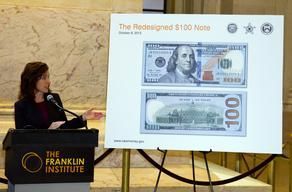Federal Reserve Issues New $100 Bill, With Features Designed To Make Counterfeiting More Difficult

It just got a little harder to counterfeit the most frequently counterfeited paper money in the world. Or at least that's what the U.S. government is hoping as it issues a newly designed $100 note.
"The new design incorporates security features that make it easier to authenticate, but harder to replicate," said Jerome Powell, Federal Reserve Board governor.
The most obvious change in the new C-note is a three-dimensional security ribbon running through the middle. It has images of bells on it that change to 100s and appear to slide from side to side when the bill is tilted. Plus, it's woven into the paper itself, not just printed on it. There is also an image of a bell inside an inkwell that changes from copper to green as the bill is moved.
There is an interactive description of the new bill posted on newmoney.gov.
Unlike other countries where all bills must be exchanged when new designs are released, the Coinage Act of 1965 states that all bills manufactured must be accepted as legal tender regardless of when they were created.
Consequently, it may take some time before average Americans will have one of these shiny new bills in their wallet. It all depends on "distance, demand and the policies of individual financial institutions," according to the press release.
The central bank, which has not been affected by the shutdown, has been in the process of creating these new bills for over three years now.
All new U.S. bills are designed and produced by the Department of Treasury, through the Bureau of Engraving and Printing, and issued by the Federal Reserve.
The initial launch date was February 2011, but in December 2010 the government announced a delay because of printing problems. The Fed said it had identified a problem with "sporadic creasing of the paper during the printing of the new $100 note."
The slip-up produced 1.1 billion bills that had to be destroyed.
The new bills cost 8 cents apiece to make, the most expensive yet but also the most secure. But until they've become more common, "you can still trust and rely on the security features in the previous hundred-dollar note” said Sonia Danburg, program manager of U.S. Currency Education Program, in a video on the Federal Reserve web site.
The last redesign of the bill was in 1996, with the addition of features such as a larger portrait and watermark.
Bills like these can be identified by their raised ink, colored fibers and security thread -- a plastic strip that isn't printed but embedded with "USA 100" printed on it. A typical $100 bill also glows pink under a black light.
In theory, the new bills will make it easier to identify counterfeiting, especially valuable for the world's most commonly counterfeited paper money.
Last week, for example, police arrested a 13-year-old with a sack of $700,000 in fake U.S. currency in Lima, Peru. The U.S. Secret Service told the AP that more than $103 million Peruvian-made fake U.S. dollars were seized last year. Such counterfeit bills are especially high quality because each one is finished by hand.
Every year, the International Association of Currency Affairs awards a different country for having the best currency -- taking into account the integrity and technology that goes into creating it.
The 2013 award-winner for "best new banknote or banknote series" was the Bank of Canada for its new series of polymer notes that last 2.5 times longer than paper notes, have a reduced environmental impact, and include hard-to-counterfeit features like transparent areas, raised ink and metallic images. Despite popular belief, they do not smell like maple syrup.
Mexico and Hong Kong also have high marks for their notes. Kazakhstan's 5,000 Tenge note has won the most awards, including the International Bank Note Society's "Bank Note of the Year" for its features that include "the Kazak Eli monument with flying doves and a panther in a vertical format on the face of the banknote," according to the IBNA site. The other side features a map of the country, mountains, an important monument and the Kazakhstan Hotel.
© Copyright IBTimes 2024. All rights reserved.





















